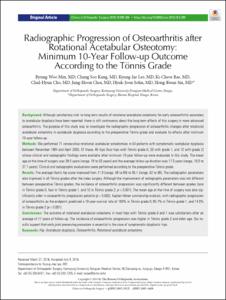KUMEL Repository
1. Journal Papers (연구논문)
1. School of Medicine (의과대학)
Dept. of Orthopedic Surgery (정형외과학)
Radiographic Progression of Osteoarthritis after Rotational Acetabular Osteotomy: Minimum 10-Year Follow-up Outcome According to the Tönnis Grade
- Alternative Author(s)
- Min, Byung Woo; Kang, Chang Soo; Lee, Kyung Jae; Bae, Ki Cheor; Cho, Chul Hyun
- Journal Title
- Clinics in Orthopedic Surgery
- ISSN
- 2005-4408
- Issued Date
- 2018
- Abstract
- Background:
Although satisfactory mid- to long-term results of rotational acetabular osteotomy for early osteoarthritis secondary to acetabular dysplasia have been reported, there is still controversy about the long-term effects of this surgery in more advanced osteoarthritis. The purpose of this study was to investigate the radiographic progression of osteoarthritic changes after rotational acetabular osteotomy in acetabular dysplasia according to the preoperative Tönnis grade and evaluate its effects after minimum 10-year follow-up.
Methods:
We performed 71 consecutive rotational acetabular osteotomies in 64 patients with symptomatic acetabular dysplasia between November 1984 and April 2005. Of these, 46 hips (four hips with Tönnis grade 0, 30 with grade 1, and 12 with grade 2) whose clinical and radiographic findings were available after minimum 10-year follow-up were evaluated in this study. The mean age at the time of surgery was 39.0 years (range, 18 to 62 years) and the average follow-up duration was 17.3 years (range, 10.0 to 27.7 years). Clinical and radiographic evaluations were performed according to the preoperative Tönnis grade.
Results:
The average Harris hip score improved from 71.8 (range, 58 to 89) to 85.1 (range, 62 to 98). The radiographic parameters also improved in all Tönnis grades after the index surgery. Although the improvement of radiographic parameters was not different between preoperative Tönnis grades, the incidence of osteoarthritic progression was significantly different between grades (zero in Tönnis grade 0, four in Tönnis grade 1, and 10 in Tönnis grade 2; p < 0.001). The mean age at the time of surgery was also significantly older in osteoarthritic progression patients (p < 0.002). Kaplan-Meier survivorship analysis, with radiographic progression of osteoarthritis as the endpoint, predicted a 10-year survival rate of 100% in Tönnis grade 0, 85.7% in Tönnis grade 1, and 14.3% in Tönnis grade 2 (p < 0.001).
Conclusions:
The outcome of rotational acetabular osteotomy in most hips with Tönnis grade 0 and 1 was satisfactory after an average of 17 years of follow-up. The incidence of osteoarthritic progression was higher in Tönnis grade 2 and older age. Our results support that early joint preserving procedure is essential in the case of symptomatic dysplastic hips.
- Department
- Dept. of Orthopedic Surgery (정형외과학)
- Publisher
- School of Medicine (의과대학)
- Citation
- Byung-Woo Min et al. (2018). Radiographic Progression of Osteoarthritis after Rotational Acetabular Osteotomy: Minimum 10-Year Follow-up Outcome According to the Tönnis Grade. Clinics in Orthopedic Surgery, 10(3), 299-306. doi: 10.4055/cios.2018.10.3.299
- Type
- Article
- ISSN
- 2005-4408
- Appears in Collections:
- 1. School of Medicine (의과대학) > Dept. of Orthopedic Surgery (정형외과학)
- 파일 목록
-
-
Download
 oak-2018-1630.pdf
기타 데이터 / 1.4 MB / Adobe PDF
oak-2018-1630.pdf
기타 데이터 / 1.4 MB / Adobe PDF
-
Items in Repository are protected by copyright, with all rights reserved, unless otherwise indicated.